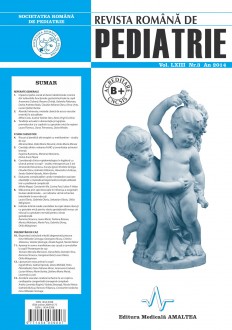SELECT ISSUE

Indexed

| |

|
|
|
| |
|
|
|

|
|
|
|
|
|
|
HIGHLIGHTS
National Awards “Science and Research”
NEW! RJP has announced the annually National Award for "Science and Research" for the best scientific articles published throughout the year in the official journal.
Read the Recommendations for the Conduct, Reporting, Editing, and Publication of Scholarly work in Medical Journals.
The published medical research literature is a global public good. Medical journal editors have a social responsibility to promote global health by publishing, whenever possible, research that furthers health worldwide.
CORELATIA DINTRE VALOAREA FENO SI SEVERITATEA ASTMULUI BRONSIC
Eugenia Buzoianu, Mariana Moiceanu and Doina Anca Plesca
REZUMAT
Obiectiv. Studiul de faţă îşi propune evaluarea corelaţiei dintre valoare FeNO şi severitatea astmului bronşic.
Material şi metodă. A fost iniţiat un studiu prospectiv care a inclus 48 de copii cu vârsta cuprinsă între 5-18 ani diagnosticaţi cu astm bronşic. Pacienţii au fost evaluaţi şi monitorizaţi în Clinica de Pediatrie din Spitalul Clinic de Copii „Dr. Victor Gomoiu“ în perioada mai 2012 – noiembrie 2013. În prima etapă, o dată cu stabilirea diagnosticului de astm bronşic, s-a stabilit şi forma de severitate, utilizând criteriile din ghidul GINA 2008, şi s-a determinat valoarea FeNO înainte de iniţierea oricărei terapii de control. Pentru formele persistente s-a iniţiat terapia de control adaptată astfel încât să se obţină starea de astm bronşic controlat. În etapa următoare, dupa publicarea ultimei versiuni a ghidului GINA 2014, s-a efectuat o a doua clasificare a astmului pe grade de severitate, ţinând cont de step-ul de tratament necesar pentru a menţine starea de astm controlat, conform recomandărilor din acest nou ghid. În final s-a evaluat corelaţia dintre valoarea FeNO şi severitatea formelor de astm, atât după clasificarea din ghidul GINA 2008, cât şi dintre valoarea FeNO şi severitatea formelor de astm după clasificarea din ghidul GINA 2014.
Rezultate. Dintre cei 48 de copii incluşi în studiu, 29 au avut valoarea FeNO normală, iar 19 crescută. Pe baza criteriilor ghidului GINA 2008 pacienţii au fost încadraţi în următoarele forme de severitate: 6 pacienţi cu astm intermitent, 27 pacienţi cu astm uşor persistent, 14 pacienţi cu astm moderat persistent şi 1 pacient cu astm sever persistent. Pe baza criteriilor din ultimul ghid GINA publicat în 2014, în formă de astm uşor au fost încadraţi 25 de pacienţi, în formă de astm moderat 22 de pacienţi, iar în formă de astm sever 1 pacient. Evaluarea statistică a corelaţiei dintre forma de astm bronşic conform criteriilor aparţinând ghidului GINA din 2008 şi valoarea FeNO a furnizat o valoare p = 0,278, iar corelaţia dintre valoarea FeNO şi clasificarea regăsită în ghidul GINA 2014 a fost de p = 0,0468.
Concluzii. Valoarea FeNO nu se corelează cu severitatea astmului bronşic stabilită pe baza clasificării din ghidul GINA 2008, dar se corelează cu severitatea astmului stabilită pe baza clasificării din ghidul GINA din 2014.
Cuvinte cheie: astm bronşic, severitate, FeNO, formă astm bronşic
Spitalul Clinic de Copii “Dr. Victor Gomoiu”, Bucuresti
Decan Facultatea de Medicina, UMF “Carol Davila”, Bucuresti
